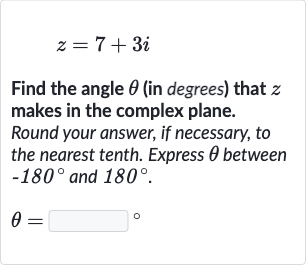Full solution
Q. Find the angle (in degrees) that makes in the complex plane. Round your answer, if necessary, to the nearest tenth. Express between and .
- Identify Complex Number: Represent the complex number in the form , where is the real part and is the imaginary part.For , we have and .
- Calculate Angle: Calculate the angle using the arctangent function, which gives the angle in radians. The formula to find the angle is .
- Convert to Degrees: Use a calculator to find the value of in radians and then convert it to degrees. radians To convert radians to degrees, multiply by . degrees
- Check Quadrant: Since the real part is positive and the imaginary part is also positive, the angle is in the first quadrant. Therefore, no further adjustments are needed for the angle.
- Express in Range: Express between degrees and degrees. Since the angle is already in the first quadrant and less than degrees, it is within the required range.
More problems from Sin, cos, and tan of special angles
QuestionGet tutor help
QuestionGet tutor help
QuestionGet tutor help
QuestionGet tutor help
QuestionGet tutor help
QuestionGet tutor help
Question
. Find the value of in degrees.Write your answer in simplified, rationalized form. Do not round.____
Get tutor helpQuestionGet tutor help

